François Lemoyne stands as a pivotal figure in the transition from the grandeur of the late Baroque to the lighter, more intimate elegance of the French Rococo. Active during the Régence and the early reign of Louis XV, Lemoyne mastered the art of large-scale decorative painting, culminating in his breathtaking ceiling for the Salon d'Hercule at Versailles. Yet, his career, marked by significant achievements and royal favour, was tragically cut short. As a painter, teacher, and decorator, Lemoyne left an indelible mark on eighteenth-century French art, influencing a generation of artists who would define the Rococo style.
Name and Identity: Lemoyne or Le Moine?
The artist is most commonly known today as François Lemoyne. However, historical records and contemporary accounts sometimes use the spelling "Le Moine." Both "Lemoine" and "Lemoyne" are recognized variants of the same French surname. Evidence suggests that variations in spelling were not uncommon during the period. For instance, other families with similar names, like that of Charles Lemoyne, saw spelling changes over time. For the purpose of clarity regarding the celebrated painter of the early 18th century, François Lemoyne (1688-1737) is the standard identification used in modern art history, distinguishing him clearly from other individuals bearing similar names across different fields and eras. His identity is firmly established as a leading painter of the French Rococo school.
Early Life and Artistic Formation
François Lemoyne was born in Paris in 1688. Showing artistic promise at a young age, he entered the studio of Louis Galloche, a respected history painter and member of the Académie Royale de Peinture et de Sculpture (Royal Academy of Painting and Sculpture). Under Galloche's tutelage, Lemoyne received a thorough grounding in the principles of academic art, focusing on drawing from life, studying classical sculpture, and mastering the composition of complex historical and mythological scenes. This rigorous training prepared him for the competitive environment of the Parisian art world.
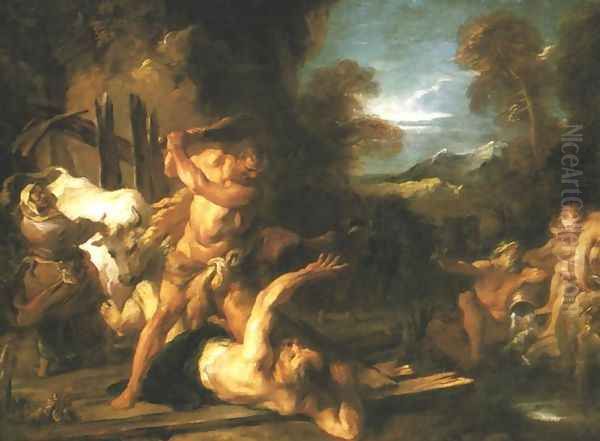
A significant milestone in his early career was winning the prestigious Prix de Rome in 1711. This prize, awarded by the Academy, typically granted the winner a period of study at the French Academy in Rome. However, due to the financial constraints of the Crown during the later years of Louis XIV's reign, Lemoyne was unable to immediately take advantage of the funded trip to Italy. Despite this setback, the recognition itself marked him as one of the most promising young painters of his generation and bolstered his reputation within the Academy.
Academic Advancement and Early Success
Lemoyne continued to build his career in Paris. He was approved (agréé) by the Académie Royale in 1716 and fully received (reçu) as a member in 1718, upon presentation of his reception piece, Hercules and Cacus. Membership in the Academy was crucial for securing prestigious commissions, both royal and private. During these years, Lemoyne began to establish his characteristic style, blending the academic tradition inherited from masters like Charles Le Brun with newer, more sensuous influences derived from Venetian painters and Peter Paul Rubens.
His work quickly gained favour. He received commissions for decorative paintings in private Parisian hôtels and churches, such as the Church of Saint-Sulpice and the Jacobins' church. His paintings were noted for their pleasing compositions, skillful drawing, and increasingly luminous colour palettes. He participated regularly in the Salon, the official art exhibition of the Academy, where his works were generally well-received, solidifying his position as a leading history painter.
The Influence of Italy
Although he missed the opportunity to study in Rome immediately after winning the Prix de Rome, Lemoyne eventually travelled to Italy in 1723-1724, accompanying his patron, the financier François Berger. This trip proved immensely influential. He immersed himself in the works of the Italian masters, particularly the great Venetian colourists like Titian and Veronese, and the Bolognese school painters such as the Carracci and Domenichino. He also studied the High Renaissance masters Raphael and Michelangelo, and the Baroque decorators like Pietro da Cortona.
The impact of Italian art, especially the large-scale decorative schemes of the Baroque, is evident in his subsequent work. His palette became brighter and more varied, his compositions more dynamic, and his handling of light and shadow more dramatic. The trip reinforced his ambition to excel in grande manière painting – large, complex compositions with historical, mythological, or allegorical subjects, considered the highest genre within the academic hierarchy. This experience would be crucial for his later work at Versailles.
The Salon d'Hercule at Versailles: A Monumental Triumph
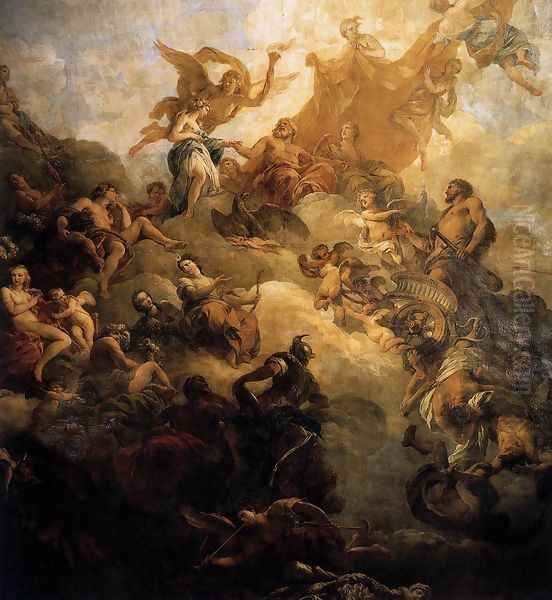
Lemoyne's crowning achievement is undoubtedly the vast ceiling painting in the Salon d'Hercule (Hercules Room) at the Palace of Versailles. Commissioned in 1729 by the Duc d'Antin, the Superintendent of the King's Buildings, the project was intended to create a magnificent new state room connecting the North Wing with the palace chapel. The subject chosen was The Apotheosis of Hercules, depicting the hero being welcomed into the assembly of the gods on Mount Olympus after his deification.
Lemoyne worked on this monumental canvas, measuring approximately 18 by 17 meters, from 1733 to 1736. It was an immense undertaking, featuring over 140 figures arranged in a swirling, dynamic composition that seems to open the ceiling to the heavens. Drawing inspiration from Italian Baroque ceiling paintings, particularly those by artists like Pietro da Cortona and Andrea Pozzo, Lemoyne created a masterpiece of illusionism, colour, and movement. The work seamlessly blends mythological figures, allegorical personifications, and dramatic architectural perspectives.
Upon its unveiling in 1736, the ceiling was met with widespread acclaim. It was hailed as a worthy successor to the decorative schemes executed under Louis XIV by Charles Le Brun, the dominant figure of the previous generation. Voltaire famously declared that the ceiling was "not inferior to any of the finest works of Venice." This triumph represented the pinnacle of Lemoyne's career and secured his reputation as the leading decorative painter of his time.
Artistic Style: Rococo Elegance and Grandeur
François Lemoyne's style exemplifies the transition from the formal grandeur of the Louis XIV era to the lighter, more graceful aesthetic of the Rococo under Louis XV. While trained in the academic tradition emphasizing drawing and noble subjects, Lemoyne infused his work with a new sensibility characterized by elegance, sensuousness, and luminous colour.
His compositions often feature flowing lines, asymmetrical arrangements, and a sense of movement that contrasts with the more static, balanced compositions favoured by earlier Baroque classicists like Nicolas Poussin or even Le Brun. Lemoyne's figures are typically elegant and idealized, rendered with smooth modeling and delicate features. He excelled at depicting rich fabrics, soft flesh tones, and atmospheric effects.
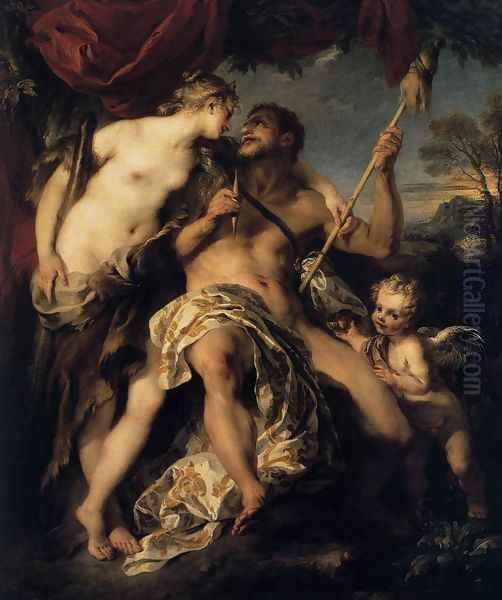
His colour palette became increasingly bright and varied after his Italian journey, influenced by Venetian masters like Veronese and the Flemish painter Rubens. He employed clearer, often pastel hues alongside richer tones, creating vibrant and harmonious effects. His handling of light is particularly noteworthy, often using dramatic contrasts (chiaroscuro) to highlight key figures and create a sense of depth and volume, while also suffusing scenes with an overall luminosity. Although capable of monumental grandeur, as seen at Versailles, much of his work possesses an intimate charm and decorative appeal characteristic of the Rococo.
Other Representative Works
Beyond the Salon d'Hercule, Lemoyne produced numerous important easel paintings and decorative works. Hercules and Omphale (1724, Louvre Museum, Paris) is a prime example of his mythological paintings, showcasing his elegant figure style, sensuous subject matter, and refined technique. The painting depicts the hero Hercules, captivated by Queen Omphale, playfully exchanging his club and lion skin for her distaff, a theme popular in Rococo art for its exploration of love's power.
Another significant work is Time Saving Truth from Falsehood and Envy (1737, Wallace Collection, London). This allegorical painting, completed shortly before his death, is often interpreted in light of his personal struggles. It displays his mature style, with dynamic composition and masterful handling of figures and drapery. Other notable works include Narcissus (c. 1728), various depictions of Venus, Diana, and other mythological figures, as well as religious paintings like The Annunciation for the chapel at Versailles. These works are found in major museums including the Louvre, the Wallace Collection, and regional French museums.
Lemoyne as a Teacher: Natoire and Boucher
François Lemoyne was not only a successful painter but also an influential teacher. He maintained an active studio and trained several pupils who would become prominent artists in their own right. His two most famous students were Charles-Joseph Natoire and François Boucher. Both artists absorbed Lemoyne's elegant style, his preference for mythological subjects, and his skill in decorative painting.
Natoire (1700-1777) became a major figure in French Rococo decoration, known for his work at the Hôtel de Soubise in Paris and his later role as Director of the French Academy in Rome. His style, while clearly indebted to Lemoyne, developed its own distinct character, often featuring charming, gracefully elongated figures.
François Boucher (1703-1770) arguably became the most quintessential Rococo painter, surpassing even his master in fame and influence. Boucher adopted Lemoyne's sensuous figure types, light palette, and mythological themes, pushing them towards a more overtly decorative and playful style that perfectly captured the taste of the era under the patronage of Madame de Pompadour. Boucher's immense success ensured the continuation and popularization of the stylistic tendencies initiated by Lemoyne.
Premier Peintre du Roi and Final Years
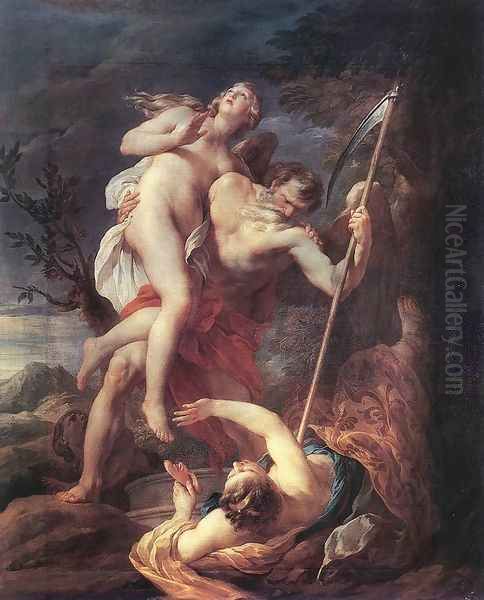
The successful completion of the Salon d'Hercule ceiling led to the highest official recognition for Lemoyne. In 1736, following the death of Louis de Boullogne, Lemoyne was appointed Premier Peintre du Roi (First Painter to the King). This prestigious position placed him at the head of the artistic establishment in France, responsible for overseeing royal commissions and advising on artistic matters. It was the culmination of his steady rise through the ranks of the Academy and the royal artistic administration.
However, this period of ultimate triumph was overshadowed by personal difficulties and deteriorating mental health. Contemporary accounts suggest Lemoyne suffered from increasing paranoia and depression. The immense pressure of completing the Versailles ceiling, combined with the loss of his wife some years earlier and perhaps professional jealousies, took a heavy toll. Despite his recent appointment and the universal praise for his work, Lemoyne felt persecuted and overwhelmed.
A Tragic End
On June 4, 1737, just months after being named First Painter to the King and shortly after completing his final painting, Time Saving Truth from Falsehood and Envy, François Lemoyne tragically took his own life in his Paris apartment. Reports state that he stabbed himself multiple times with his sword. His suicide shocked the Parisian art world and brought a sudden end to a brilliant career. His death was widely lamented, seen as a great loss to French art. The reasons behind his despair remain debated, often attributed to a combination of overwork, melancholic temperament, and perceived slights or rivalries within the competitive art scene.
Legacy and Influence
François Lemoyne's legacy lies in his crucial role in shaping the French Rococo style, particularly in the realm of large-scale history and decorative painting. He successfully adapted the grandeur of the Baroque tradition to the lighter, more elegant tastes of the early 18th century, creating a style that was both monumental and graceful. His work at Versailles, especially the Salon d'Hercule ceiling, remains one of the high points of French decorative art.
His influence extended significantly through his pupils, Boucher and Natoire, who became dominant figures of the next generation, ensuring the continuation of his stylistic innovations. His approach to colour, light, and composition also impacted other contemporaries like Jean-François de Troy and Carle Van Loo, who were also active in creating large decorative schemes. Even artists associated more with genre painting or portraiture, such as Jean-Baptiste Oudry, worked within the broader Rococo aesthetic that Lemoyne helped to define.
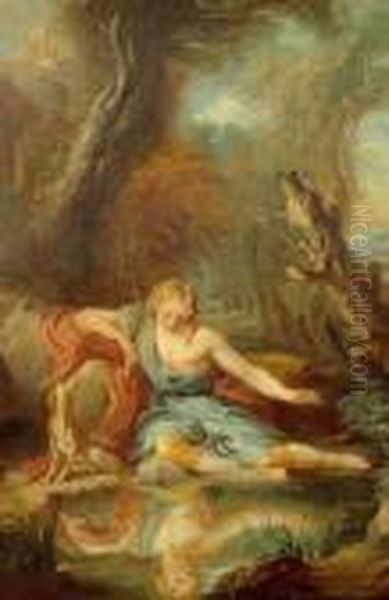
While the Rococo style eventually gave way to the more austere Neoclassicism later in the century, Lemoyne's achievements continued to be recognized. He represented a bridge between the era of Charles Le Brun and the high Rococo of Boucher, demonstrating that the French tradition of grand decorative painting could be renewed with grace, colour, and light. His ability to blend Italianate influences with French elegance created a distinctive and influential artistic voice. Though his life ended tragically, François Lemoyne's contribution to French art remains significant, celebrated for its technical mastery, decorative brilliance, and historical importance. His works continue to be admired in museums and palaces, testaments to a master who captured the spirit of his age.